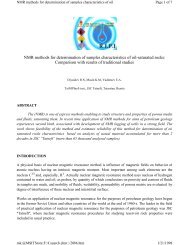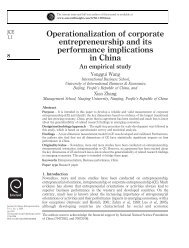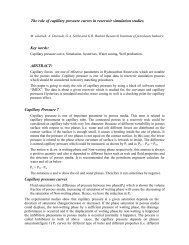Corporate entrepreneurship: teaching managers to be entrepreneurs
Corporate entrepreneurship: teaching managers to be entrepreneurs
Corporate entrepreneurship: teaching managers to be entrepreneurs
Create successful ePaper yourself
Turn your PDF publications into a flip-book with our unique Google optimized e-Paper software.
that their idea has commercial merit, they <strong>be</strong>gin <strong>to</strong> build an organization ofpeople and resources <strong>to</strong> go about capturing the opportunity.Identifying and shaping ideas can <strong>be</strong> learned. We have many great examplesof <strong>managers</strong> who never considered themselves creative or innovative, whofound significant new business opportunities as a result of their entrepreneurialtraining. A Siemens manager, for example, found a unique way <strong>to</strong> s<strong>to</strong>p creditcard fraud through fingerprinting technology. A PDVSA team identified ahuge commercial market for one of their waste products that they used <strong>to</strong>throw away. A Mott’s employee identified a way <strong>to</strong> start a spin-off business,based on Mott’s back-office competencies. None of these opportunities wouldhave <strong>be</strong>en discovered had these participants not <strong>be</strong>en exposed <strong>to</strong> a trainingmilieu, in which ideas were not only encouraged and supported but challengedas well. So, the ability <strong>to</strong> think creatively and <strong>to</strong> <strong>be</strong> innovative is a humancondition. Some people exhibit these tendencies naturally while others need acatalyst for these inherent capabilities <strong>to</strong> emerge. Education and particularlycoaching turned out <strong>to</strong> <strong>be</strong> two of the most important ways in which innovationand creativity were stimulated <strong>to</strong> emerge. What the <strong><strong>entrepreneurs</strong>hip</strong> trainingdid most effectively, was give participants the <strong>to</strong>ols, techniques, and discipline<strong>to</strong> distinguish <strong>be</strong>tween a good idea and a good opportunity.Clearly, the most “teachable” aspect of the opportunity process is thebusiness plan. Business plans have both clear structure and clear contentrequirements. In fact, the business plan was perhaps our most important<strong>teaching</strong> <strong>to</strong>ol. All the theory, case studies, and group discussions could notreplace the tremendous amount of learning that went on when participants wererequired <strong>to</strong> turn their idea in<strong>to</strong> a full-blown business plan. The written businessplan is one of the few ways that we could determine whether the participant’sidea was just that, an idea, or a commercial opportunity. Every participant whocompleted a business plan said it was the most important (and perhaps one ofthe most painful) learning experience about <strong>be</strong>ing an entrepreneur that they hadever had. Managers who have gone through the development of a completedbusiness plan are not the same when they finish. They have had <strong>to</strong> learn aboutmarketing, finance, value, cash flow projections, etc., <strong>to</strong> a point where they canstand in front of their peers, senior <strong>managers</strong> or venture capitalists and convincethem that their opportunity is worth investing in.It was also interesting that many of the program participants said theyeither knew how <strong>to</strong> write a business plan or had already written one prior <strong>to</strong>coming <strong>to</strong> the program. It was clear from our experience that very few of thesepeople actually had business planning skills that would pass muster in front ofa venture capitalist or an internal venture officer.<strong>Corporate</strong><strong><strong>entrepreneurs</strong>hip</strong>337Identifying people with the “right stuff”One of our most surprising results, and one that we had not predicted, was thatwe were not able <strong>to</strong> predict with any reasonable certainty which <strong>managers</strong>
















